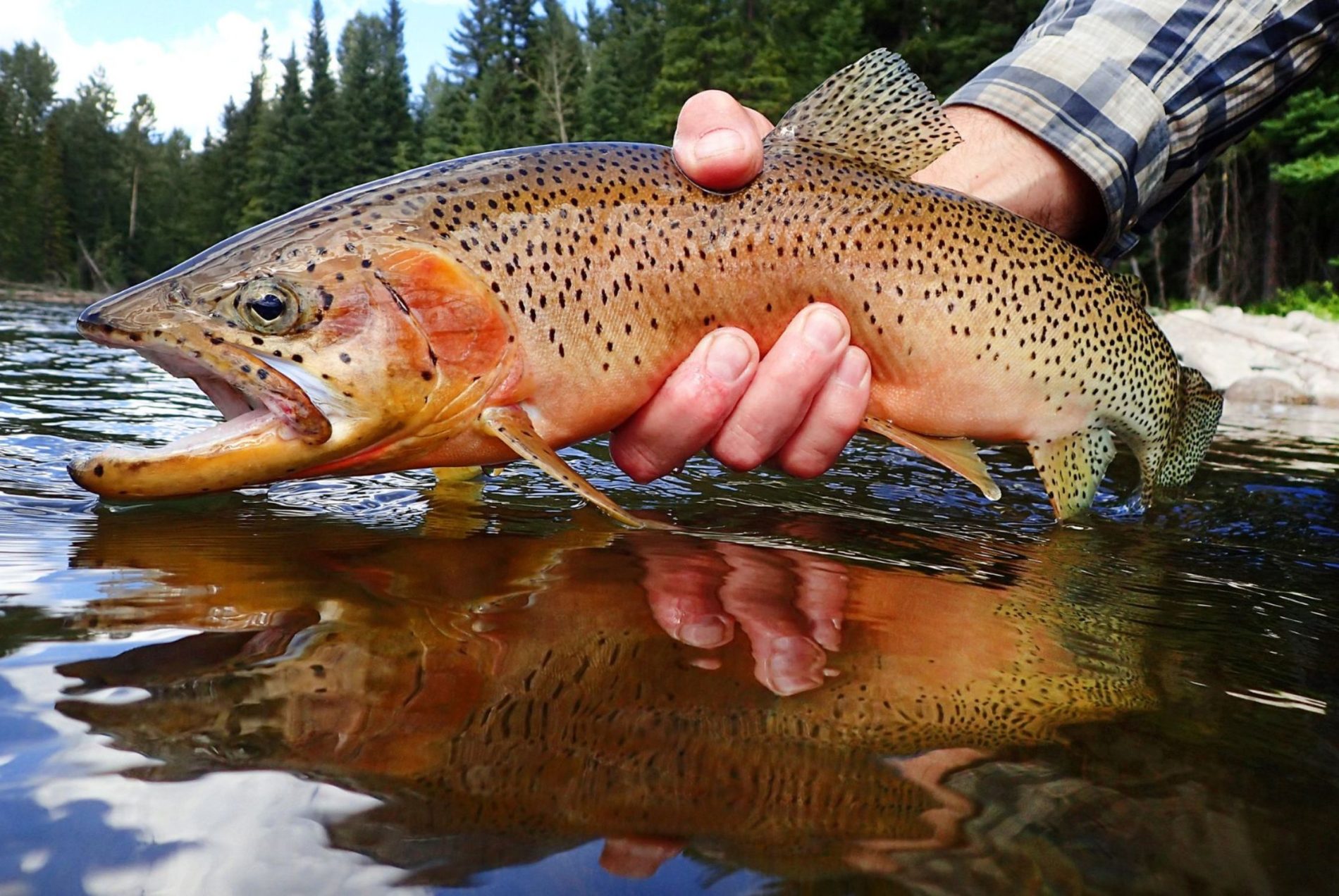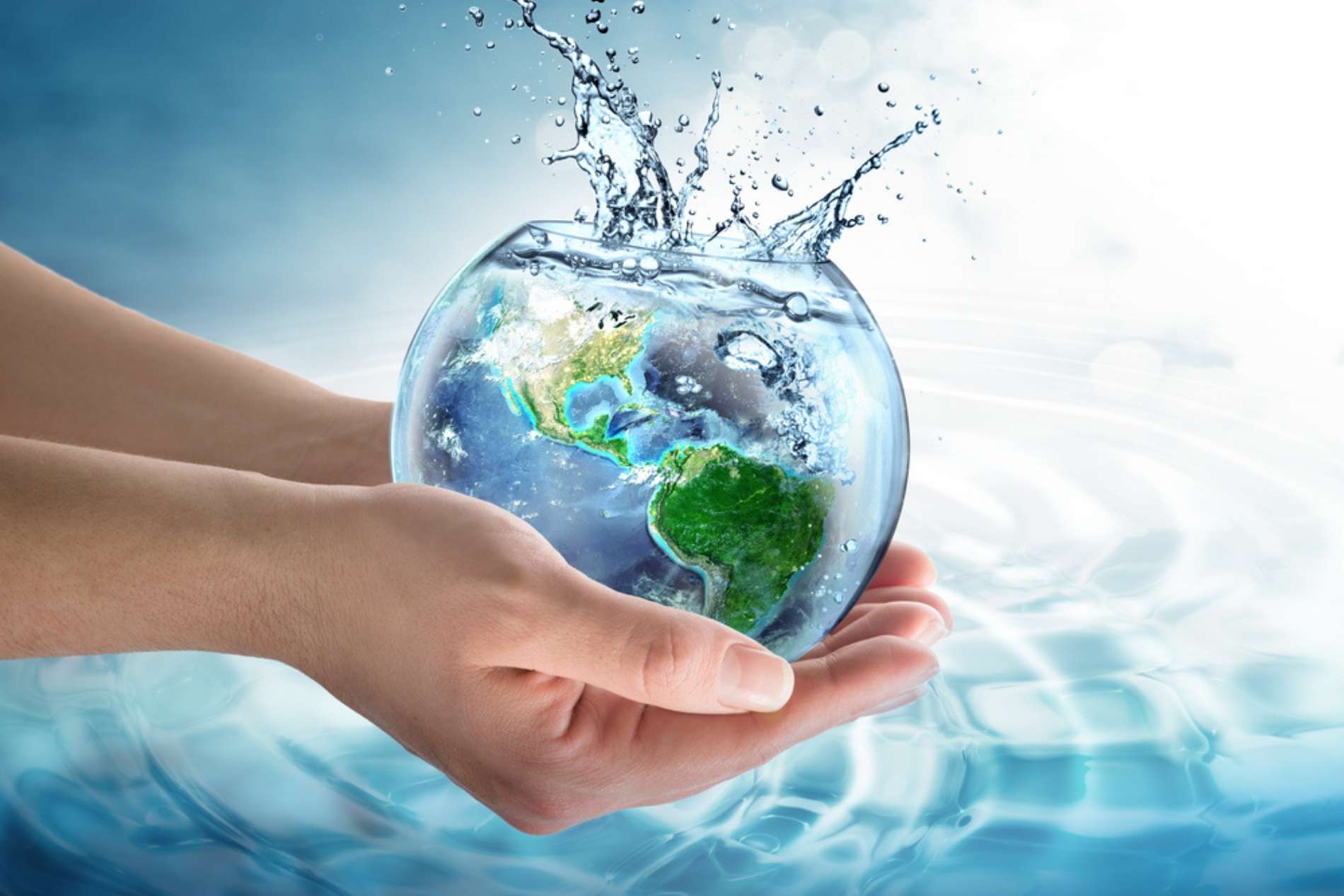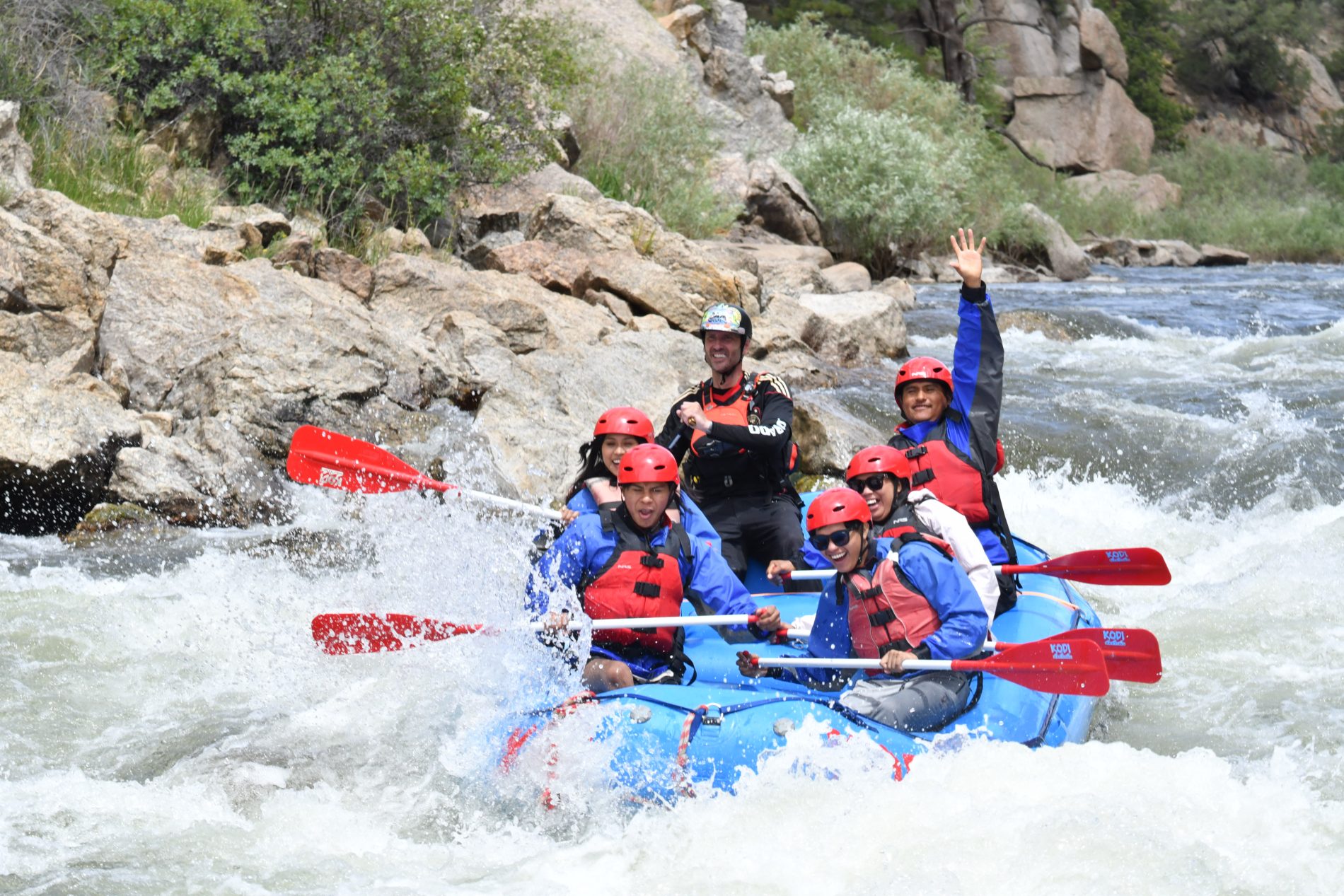Whitewater River Rafting or Animal Watching?
Stop and take a deep breath… Feel the wind and experience the sights of Colorado’s wild animals from the seat of a whitewater raft.
Whether you’re hiking trails or paddling the rapids of the Arkansas, Clear Creek, Blue, or Colorado rivers with Kodi, you’re guaranteed to see some wildlife! Colorado’s diversity of landscapes and vegetation is home to a wide variety of wildlife like the bighorn sheep, elks, golden eagles, and varieties of trout.
We want to provide a quick reminder to never feed or disturb any wildlife. For more information on the leave no trace ethos, check out our recent blog.
Fish in Colorado’s Rivers – Rafting
When you’re whitewater rafting the Numbers, Browns Canyon, or Pine Creek you may be lucky enough to see some fish. The main fish population in the Arkansas, Clear Creek, Blue, and Colorado rivers are brown and rainbow trout, but you’ll occasionally see some Brook Trout too. Another animal you’ll commonly spot in the rivers are Beavers! Beavers aren’t fish obviously, but there is a possibility you will see them and their amazingly clever dams.
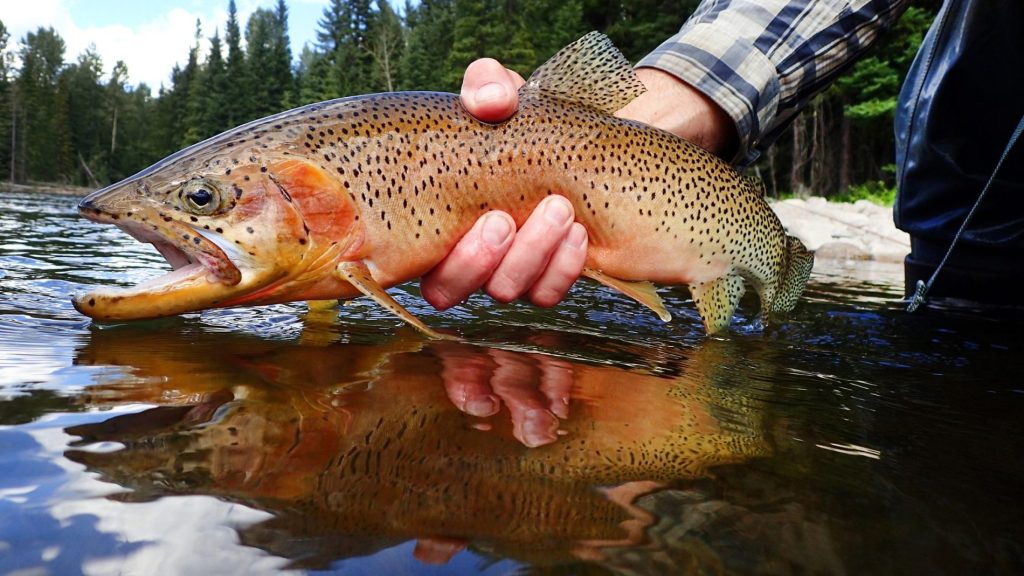
Did you know the Colorado native trout before the 1850s was the greenback cutthroat trout? The Arkansas river used to be teeming with greenback cutthroat trout, but sadly the mining runoff in Leadville killed this fish species in the valley of Buena Vista. You may be asking yourself, HOW? Greenback cutthroat trout died due to a heavy amount of metal contamination and soil erosion. However, Leadville National Fish Hatchery is working to resolve that since the greenback cutthroat trout are endangered, and it’s their main priority to repopulate the surrounding rivers and lakes.
A long-spoken legend between the senior whitewater river rafting guides is that Northern pike fish have been caught in the Arkansas River. Northern pike are high alpine lake fish that like deep and cold water, but sometimes they’re flushed out of the lakes and have been found in our rivers! There are no guarantees of seeing a pike, but the senior river guides swear by this tale.
Unfortunately, we don’t allow fishing from the rafts because of the other guests on your boat, but if you are looking to fish be sure to check out the requirements for your fishing license in Colorado and some rules and regulations you can reference to legally fish in Colorado.
Colorado’s Birds as Seen Overhead From the River
When rafting, it’s easy to forget to look up, but we highly encourage it! Here in Colorado, you will see great blue herons, bald and golden eagles, turkey vultures, and Corvus. Common birds you may spy are sparrows, robins, and swallows. The swallows are very prevalent when it is raining/drizzling. Did you know that birds predict the weather? When it’s raining, swallows fly low because they have very sensitive ears. When the barometric pressure drops, swallows will fly as close to the ground as possible because the air density is greatest the lower they go.
Another common bird you or guide will often spot are in the Corvus family, which includes ravens, crows, and magpies. You won’t miss these birds, as they are very noisy!
Some striking birds you have a possibility of seeing are the red-winged blackbird, blue jay, North American goldfinch, and steller’s jay. The steller’s jay looks like a metallic blue bird, and is super unusual and truly beautiful. Check out the photo below of a steller’s jay in the wild.
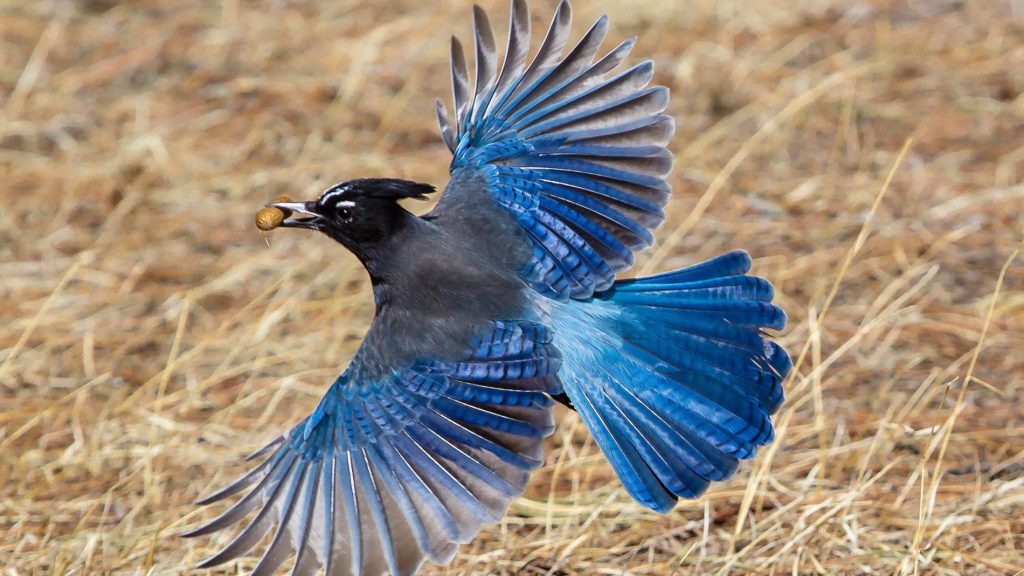
Some rare birds that are less likely to cross your path but you may be lucky enough to see are the western tanager, great blue herons, bald eagles, and golden eagles.
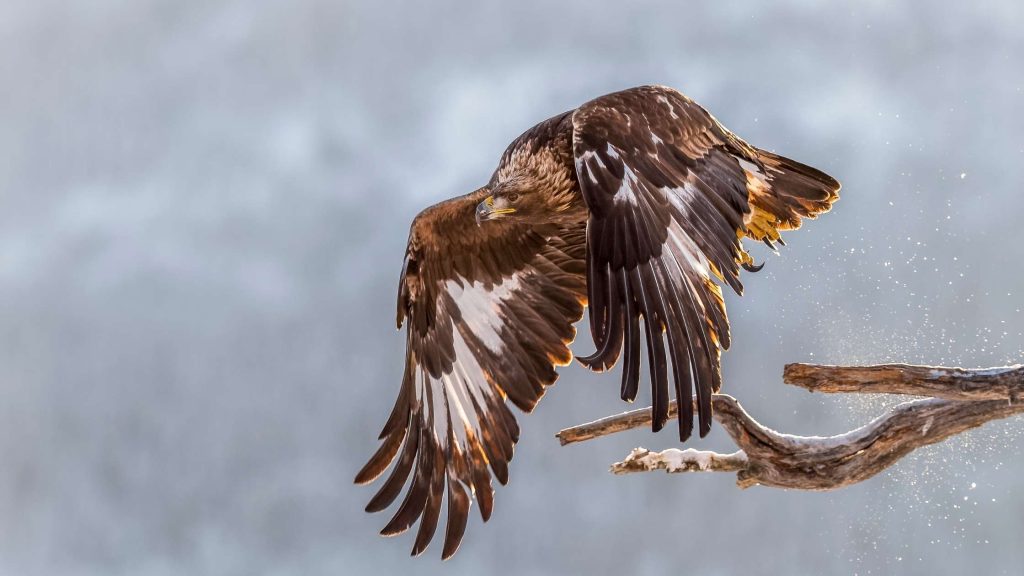
Birds we can almost guarantee you will see are peregrine falcons, turkey vultures, and good old Canada geese, as well as the occasional duck or two!
If you would like some more pictures of birds and wildlife animals in Colorado, be sure to check out FDRD, Friends of the Dillon Ranger District which also offers more information about our forests.
Colorado’s Land Animals in The White River National Forest
Colorado is the land of the wild for larger wild animals as well. Yes, there is a possibility you’ll come across black bear, elk, mountain lions, coyotes, red foxes, moose, bobcat, mule deer, white tail deer, porcupine, pikas, snowshoe hare, Rocky Mountain bighorn sheep, and mountain goats. Did you know that snowshoe hare’s beautiful coat changes colors with the season? In the wintertime, snowshoe hares are white to disappear into the snow and in the summer they turn a nice shade of brown to blend in with the forest floor and bushes. When whitewater river rating, our groups can get very loud and animals hate loud noises, so it’s less likely you’ll see any of the larger animals, but we definitely get a glimpse on occasion.
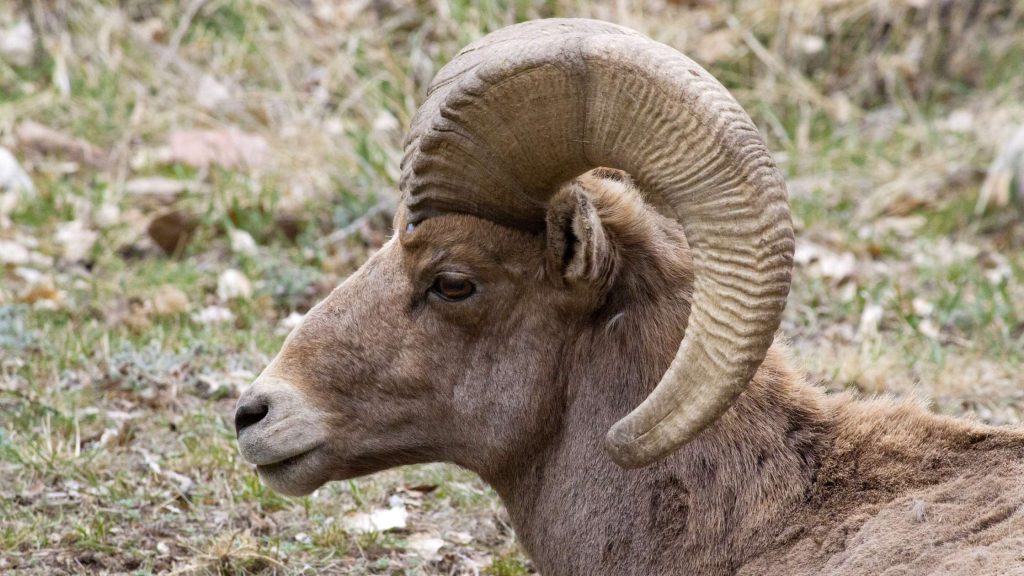
There are many Colorado marmots that you may see or just hear. The largest of the Colorado land squirrels is the yellow-bellied marmot. The yellow-bellied marmot hibernates throughout the winter, and when approached you will hear a loud warning whistle, which is very unique and earns these animals the nickname “whistle pigs.”
Recently, gray wolves were reintroduced into the Colorado mammal landscape. We have never seen any wolves on our rafting trips to date, but there have certainly been sightings of them throughout the plains and in the ranching communities. In the gray wolf reintroduction process through natural migration, one pack has already established itself in the North Park Mountain Valley near Walden, Colorado, but we have not seen any near the Upper Colorado River, the Arkansas River, or the Blue Rivers.
Ready to animal watch from a whitewater raft? Call and get signed up for your next Colorado adventure in Buena Vista, Breckenridge, Frisco, Idaho Springs, Kremmling, or Cortez Colorado through Kodi Rafting. If you have any questions about what raft trip will be best for you and your friends or family feel free to give us a call at 877-747-RAFT. We are always happy to answer all your questions and recommend the ideal trip for you!!
Kodi Water Conservation
Let’s face it. We can’t very well go whitewater rafting without water conservation. Water conservation is much more than picking up your trash. It’s recognizing the issue and spreading awareness. It’s working as a community to leave clean water for the next generation. Take a look at some of our conservation and Leave No Trace ethos.
We love our rafting our white waters here in Colorado. But how does water quality affect your rafting life and why should you take part in managing it? We’re going to dive into Colorado water conservation and answer those questions for you.
What Makes Colorado Water Special?
Here in Colorado, we’re known as the headwaters state. Water flow from melting snowpack starts here in our mountains and runs to 18 states in the US through the Arkansas River. Plus the Colorado River flows into Mexico, making our water International. We also have eight major river basins and several aquifers. That’s a lot of water! But when water starts here, so does our need to be careful in our management of this life-giving asset. And to enjoy whitewater rafting for years to come, we have to work at protecting and conserving our whitewater.
What Issues are Affecting Our Rivers? 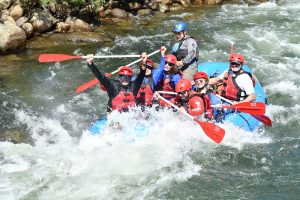
On a planet that’s made up of 71% water, why are we worried about running out? With droughts and climate change, fresh water levels are dropping to record low levels. Glaciers of freshwater are melting into the sea. And increased demand by agriculture, manufacturing, food production, power generation, lawns, pools, and household use means land is drying up. Pollution and runoff from heavily populated areas clog up our rivers and streams. It doesn’t take a rafting enthusiast to be passionate about water conservation. But whether you’re at home or in a raft and shooting the rapids, there are things we all can do.
What Are the Benefits of Water Conservation?
Water Flow
Can you imagine a whitewater rafting trip without the rapids tossing you around? That fun chaos in white, frothy water is because of rapid water flow over rocks and other features on the riverbed. The waters you traverse, like the Arkansas River and Colorado River, depend on healthy river flow. And without it, your rafting trip comes to a halt. But water flow does more than that. Plants and animals depend on moving water to live. The flora and fauna of Browns Canyon are an example. So when you put your oars in the water, that forward motion is a sign of great water conservation!
Water Metering
As stewards of this planet, we must responsibly use water. That’s why water metering is so important. You know of it in your house and see it when you pay your water bill every month. Metering controls the amount of water entering the property. This plays a huge role in water flow as well. Metering also takes place at dams, controlling water levels and flow, controlling the amount of water released from a reservoir down river. This allows you to navigate the white water rapids in your raft.
How Can I Protect Our Rivers for Rafting?
Know Where Your Water Starts
If you’re a local Coloradan, it’s not hard to identify where your water comes from. Snow fall from September through May builds up and waits until summer to melt and flow down the mountains and into our reservoirs, rivers, and homes. Find out where your water company sources your household water from. Or check out the EPA’s page on water mapping. Knowing where your water originates can instill pride and care for taking care of it. And on that next whitewater rafting trip, you can smile knowing you know where the water starts and how it ends up under your Kodi raft.
Protect the Storm Drains
No one wants to take a trip down a river that’s oily and filled with trash. Rafting aside, plant and animal life suffer as well. Did you know that the storm drain at your curb leads directly and unfiltered to your water source? Anything that goes into the storm drains ends up in the water. That’s why it’s important to ensure only rainwater flows into them. Absolutely no dumping from changing your engine’s oil. And of course trash goes in the proper receptacles.
Keep the Yard Under Control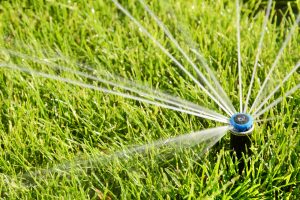
Certain types of turf can be detrimental to water conservation. Some species of grass need large amounts of water. And in times of drought and hot weather, the outcome can be rough on your water supply. Easy approaches like replacing your plants with more drought-conscious species does wondrous things. Rock gardens in place of large swaths of green grass are a nice option. And drought-resistant and species with low water requirements make your life easier by not needing to water all the time, and to ensure your water bill stays as low as possible. Keep the water in the river and raft it instead!
Always Use Water Wisely
An average bath uses anywhere from 35-50 gallons of water each time you jump in your soaking tub. If the grass and plants aren’t wasting it, bathing is. Now that doesn’t mean we’re advocating for lax hygiene. No, hopping in one of our rafting boats without washing first (it’s awkward for everyone) is not our recommendation at all! Turning off the water when brushing your teeth or doing dishes is a great place to start. Switching to showers drops water usage from that 35-50 gallons to just 10 gallons. And you can even shut off the shower water while soaping up to be extra conservative. That time and water saved is well spent on a white water rafting trip with your family.
There are many more ways you can go about water conservation where you live. Like cleaning up after your pets and keeping your lawn a longer length to protect the soil and avoid evaporation, fix any household leaks, and avoiding using salt on icy sidewalks. Learn more about #Water22 tips for water conservation. And did you know that March 22nd is World Water Day? There’s no need to wait until your next whitewater rafting trip down the Colorado River to understand the importance of our water management here in Colorado that flows downstream to so many others.
Everything is a hierarchy and the water world is no different. As human beings, we’re at the top of the water food chain. This means we must take care of our resources. We know you’re excited to get out on the water and experience whitewater rafting. But rafting far into the future requires clean, healthy water. It’s a cause we all have to contribute to. If you want to see what you’re fighting for, book a trip with Kodi Rafting, and let’s get you out on a raft trip!
Leave no trace... We are committed to conserving our magnificent rivers and wild spaces.
Leave the roads; take the trails. – Pythagoras.
Here in Colorado, we love the great outdoors because it gives us the ability to enjoy the beauty and solitude of nature. Whether you’re hiking, mountain biking, whitewater rafting, rock climbing, or kayaking down the river, it’s crucial to enjoy these recreational activities with a “leave no trace” mentality. You might be thinking… Why leave no trace? The answer is simple: we want to keep the great outdoors clean, the wildlife wild, and our fellow humans safe.
To fully protect beautiful Colorado and the Colorado rivers, let’s first start with understanding the Seven Principles of Leave No Trace, and then we can learn how to put them in place.
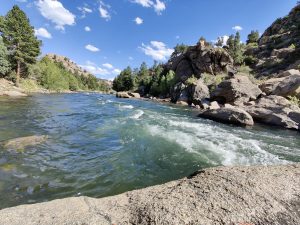
What are the seven principles of Leave No Trace Principles of River Rafting?
Principle 1: Plan ahead and prepare.
- Planning ahead makes your outdoor boating adventure safer for you and the outdoors. Don’t be the group that is unprepared and has a miserable time or is in danger due to your lack of proper equipment and planning. Here at Kodi, we do the planning for you… from clothing like helmets and wetsuits to drinking water for your whitewater rafting day trip. To better prepare for your raft trip please read our article on what to wear to go whitewater rafting.
Principle 2: Travel and camp on durable surfaces
- Be a low-impact camper and adventurer when exploring the outdoors. Rafting leaves less trace than normal outdoor activity because traveling down the river on a raft technically leaves no trace. However, our trace starts when we step on land or allow anything from our raft to fall into the river. When at the put in and take out please keep this in mind. When hiking or exploring, stay on the trails and when camping, try to choose big enough campsites for your whole group, therefore you will not have to damage the terrain surrounding your camp.
Principle 3: Dispose of waste properly
- Kodi lives by the motto… We leave the outdoors better than we found it in order to keep our “Good River Karma”. This means we pick up all trash that isn’t from our group, and we encourage our adventurous whitewater rafting clients to do the same! Things you shouldn’t leave behind are trash, gear, food (yes, even banana peels), and human waste. Just remember to pack it in and pack it ALL out.
Principle 4: Leave what you find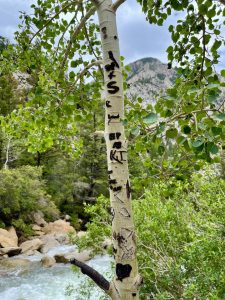
- Leave what you find means just what you think it means… Don’t take that “cool” rock. Don’t dig a trench for your tent. Don’t construct lean-tos. Don’t cut down a tree to burn as your firewood. Certainly don’t pick wildflowers (they need to go to seed and regenerate for next season!) Your initials are cute but please don’t carve them into a tree! Always remember to minimize our alterations to the outdoors, so everyone can enjoy the beauty without seeing you were there before!
Principle 5: Minimize campfire impact
- One of the best parts of camping is enjoying stories around a campfire with your friends and loved ones. Whether you like to sit around the campfire and tell scary stories, drink a cold one, or roast some marshmallows into s’mores, we want to do it in a minimal impact way. For more information and tips on minimizing your campfire impact, go here.
Principle 6: Respect wildlife
- Seeing wildlife while rafting down the Arkansas, Clear Creek, Blue, and Colorado rivers is common and we love to enjoy these majestic animals from a distance, however wildlife is easily scared by loud noises, and quick movements. Respecting wildlife is simple… Please never disturb or feed the wildlife. You are encouraged to enjoy the wildlife from a distance so they do not become scared and feel forced to leave. And any human food can mess with their systems and in the case of bears even get them killed if they become too comfortable around people and campsites. Don’t be that forest visitor.
Principle 7: Be considerate of others
- You are not the only one who loves to take advantage of the Rocky Mountain outdoors, so remember to be kind and considerate to your outdoor neighbors! Often we are sharing the rivers with our fellow raft companies’ guides and clients, so please respect them. When boating the Arkansas River, Colorado River, or any river, you will raft through many private properties, so do remember to respect the private property you’re boating through.
For more about the 7 principles of “leave no trace”, kindly go here.
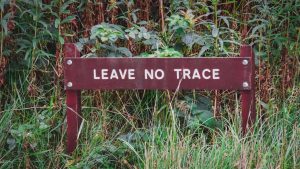
Join us at Kodi and live by the Leave No Trace Principles of Whitewater River Rafting to reduce our paddlers’ footprint. We leave what we find, we take photographs and epic memories but nothing else; so book your summer rafting trip or call us at (877) 747-RAFT and we can practice minimum impact on our outdoors together while having a blast!

